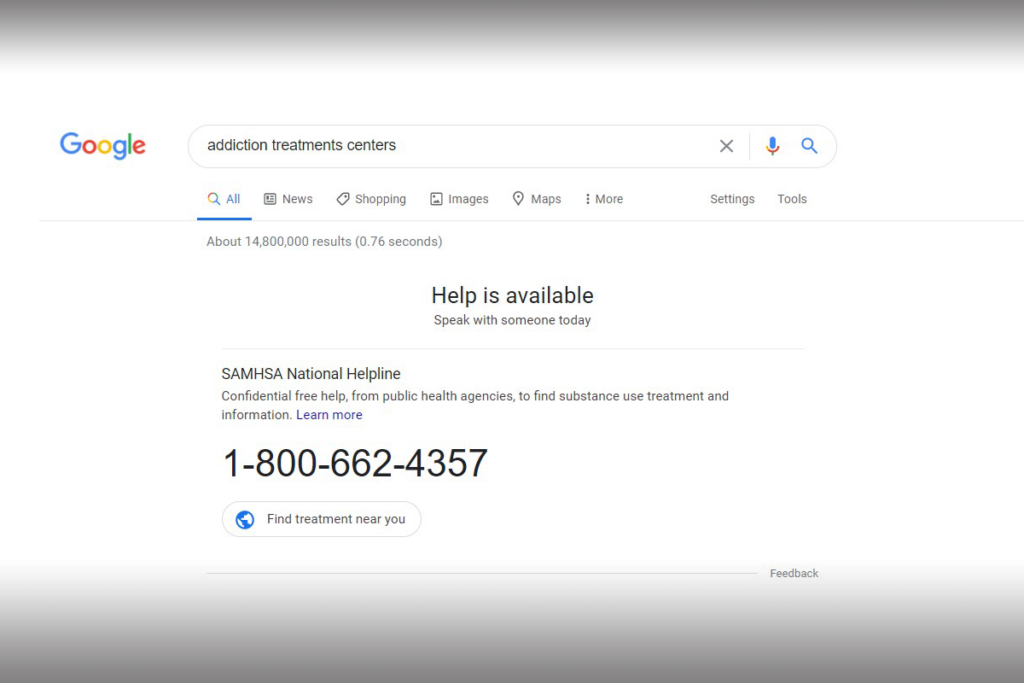In June of 2020, a new banner appeared above Google search results when people searched for “addiction treatment centers.” The banner prominently displayed the words, “help is available” as well as a SAMHSA (substance abuse and mental health services administration) addiction hotline phone number. SAMHSA on Google’s search banner remains in place. In fact, this banner now appears when users search for a variety of addiction-related terms.
The Significance of the Google Hotline Box
The area of the page that shows the SAMHSA phone number is known as a Google hotline box. For now, Google determined to continue using these hotline boxes for addiction-related search terms. The search engine uses these hotline boxes for any search that suggest an emergency could be taking place for the user. Putting SAMHSA on Google’s search banner is one way to assist those who may be in crisis.
With the phone number for SAMHSA occupying the top of the Google SERP, ads have moved to a position beneath the hotline or, in some cases, to the bottom of the search page. Being placed at the top of the page is important. Generally, what’s at the top of the page is what gets the most clicks. Therefore, this prominent real estate helps get SAMHSA’s message across.
Google’s decision to endorse the hotline, combined with the authority that SAMHSA commands as a government behavioral health directory, matters a great deal. Without question, SAMHSA on Google’s search banner suggests a lot of people will be calling the phone number. How that plays out for facilities involved in substance abuse prevention is perhaps more complicated.
How the Addiction Treatment Industry is Impacted
Clearly, SAMHSA on Google’s search banner is a wonderful thing for SAMHSA. For addiction treatment facilities, however, there may actually be less cause for celebration. By handing SAMHSA this space, the purpose and value of LegitScript is suddenly challenged.
LegitScript certification was created to address a very real problem in the addiction treatment industry. In 2018, everyone had had enough of unethical addiction treatment marketers. To deal with the situation, Google demanded a verification process known as LegitScript certification for addiction marketers. This requirement effectively kept unethical players from buying addiction ads.
Addiction treatment centers spend thousands to achieve LegitScript so that they can run Google Ad campaigns. If putting SAMHSA on Google’s search banner diminishes these efforts in any way, there’s a problem. Given that centers wanting to list on SAMHSA don’t jump through as many hoops as they do to get LegitScript certification, yes, that qualifies as a problem.
How Prospective Patients Are Impacted
There are many possible negative implications of SAMHSA dominating the Google search banner. Two, however, are particularly unfortunate.
Recommendations Could Be Inappropriate
Every addiction treatment center isn’t right for every patient. Some may need to go to a center with very specialized treatment modalities. Others may prioritize cost or location or amenities. None of these concerns can be addressed with SAMHSA recommendations. It simply isn’t how things are set up. Google search, on the other hand, is ideally suited for pointing patients toward those centers that most closely align to their search perimeters. SAMHSA on Google’s search banner potentially interferes with prospective patients finding their best treatment options.
SAMHSA Doesn’t Screen Out Unethical Players
The truth is that many non-certified centers can be found on SAMHSA. While SAMHSA itself is reputable, that doesn’t mean all of its recommendations necessarily are.
An addiction treatment center’s most sacred responsibility is to provide the right treatment for the right patient in an ethical manner. Most facilities take this idea very seriously. Some, however, do not. Therefore, it would be illogical to present both types of centers as equally appropriate choices for prospective patients. In fact, they aren’t. That first type of facility helps patients. The second is more concerned with profiting off of them.
How the User Experience is Impacted
Google search results are supposed to be all about choices. With SAMHSA dominating real estate on the search engine results page, all of the other choices are instantly minimized. In addition, is SAMHSA really in a position to respond to a high volume of addiction-related calls? Consequently, wouldn’t it better to spread those inquiries out to reputable facilities screened by the LegitScript process?
SAMHSA on Google’s Search Banner: What It Really Means
At first glance, SAMHSA on Google’s search banner seems like a good idea. But is it? By pushing everyone through only one portal—SAMHSA—Google seems to be violating one of its own rules. Shouldn’t they be offering lots of choices rather than just one?
Google’s understanding of the addiction treatment space has never been profound. To be fair, no one can ever expect that of them. Therefore, it’s time for those in the industry to speak up and give feedback to Google about moving SAMHSA’s box back to its normal organic placement. Let SEO do the job it was meant to do. Don’t forget that there’s a feedback link in the lower right hand corner of the search banner. Let’s make all of our voices heard.







